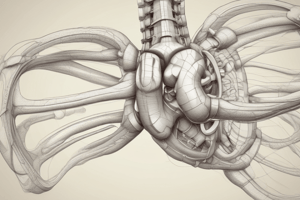Podcast
Questions and Answers
What is the sacroiliac joint?
What is the sacroiliac joint?
Medial, posterior, and superior; transmits weight from axial spine; can affect angle and rotation of acetabular fossa.
Describe the Pubic Symphysis.
Describe the Pubic Symphysis.
Medial, anterior, and inferior; point of stabilization for both hips; can affect angle and rotation of acetabular fossa.
List the three inominant bones.
List the three inominant bones.
Ilium, Ischium, Pubis.
The anatomical landmarks include the _____ and PSIS.
The anatomical landmarks include the _____ and PSIS.
What are palpatory landmarks?
What are palpatory landmarks?
What defines a true ligament?
What defines a true ligament?
What is an accessory ligament?
What is an accessory ligament?
What is the purpose of ligaments?
What is the purpose of ligaments?
List the ligaments of the pelvis.
List the ligaments of the pelvis.
What does the iliolumbar ligament restrict?
What does the iliolumbar ligament restrict?
How does the sacrospinous ligament function?
How does the sacrospinous ligament function?
What is the role of the sacrotuberous ligament?
What is the role of the sacrotuberous ligament?
Describe the sacroiliac ligament.
Describe the sacroiliac ligament.
What are the muscles of the inominates?
What are the muscles of the inominates?
What is the function of hip flexors?
What is the function of hip flexors?
Which muscles are considered hip extensors?
Which muscles are considered hip extensors?
What is the role of hip adductors?
What is the role of hip adductors?
What is the function of hip abductors?
What is the function of hip abductors?
What do hip external rotators do?
What do hip external rotators do?
Describe the piriformis muscle.
Describe the piriformis muscle.
What types of motion do inominates perform?
What types of motion do inominates perform?
What characterizes an anterior pelvic tilt?
What characterizes an anterior pelvic tilt?
What defines a posterior pelvic tilt?
What defines a posterior pelvic tilt?
Flashcards are hidden until you start studying
Study Notes
Sacroiliac Joint
- Located medial, posterior, and superior; critical for weight transmission from the axial spine.
- Influences the angle and rotation of the acetabular fossa.
Pubic Symphysis
- Positioned medial, anterior, and inferior; stabilizes both hips.
- A secondary cartilaginous joint, featuring hyaline cartilage and fibrocartilage, allowing slight movement.
Inominate Bones
- Composed of three bones: ilium (largest and superior), ischium (inferior and posterior), and pubis (inferior and anterior).
Anatomic Landmarks
- Notable landmarks include iliac crest, ASIS (anterior superior iliac spine), AIIS (anterior inferior iliac spine), pubic tubercle, PSIS (posterior superior iliac spine), and PIIS (posterior inferior iliac spine).
Palpatory Landmarks
- Key palpatory points include ASIS, pubic tubercles, iliac crest, greater trochanters, medial malleoli, midline from ASIS, PSIS, sacral sulci, and ischial tuberosity.
Ligaments
- True Ligaments connect bone to bone.
- Accessory Ligaments connect bone to ligaments, tendons, or fascia.
- Purpose: limit abnormal movement, allow normal motion, provide elasticity, and participate in reflex responses to excessive movements.
Ligaments of the Pelvis
- Key ligaments include iliolumbar (accessory), sacrospinous (accessory), sacrotuberous (accessory), and sacroiliac (true ligaments: anterior, interosseous, posterior).
Iliolumbar Ligament
- Connects ilium to the 5th lumbar vertebra.
- First ligament associated with low back pain; restricts anterior motion and some rotation of L5.
Sacrospinous Ligament
- Extends from the sacrum to the ischial spine, dividing spaces into greater and lesser sciatic foramen.
- Part of the coccygeus muscle; resists anterior movement of the sacrum alongside the sacrotuberous ligament.
Sacrotuberous Ligament
- Runs from the sacrum to the ischial tuberosity, helping to check anterior movement of the sacrum.
- Has four attachments for muscles: gluteus maximus, long head of biceps femoris, piriformis, and pelvic fascia.
Sacroiliac Ligaments
- Cover most areas of the sacroiliac joint, categorized into anterior, interosseous, and posterior portions.
Muscles of the Inominates
- Functionally categorized into flexors, extensors, adductors, abductors, and external rotators.
Hip Flexors
- Anteriorly rotate the pelvis; hip flexor contractures indicated through:
- Iliacus (from ala to lesser trochanter)
- Psoas (from 5th lumbar vertebra to lesser trochanter)
- Iliopsoas muscle complex
- Rectus femoris and sartorius.
Hip Extensors
- Posteriorly rotate the pelvis; hip extensor contractures indicated through:
- Semimembranosus, semitendinosis (ischial tuberosity to medial tibia)
- Biceps femoris and gluteus maximus.
Hip Adductors
- Stabilize and medially pull the pelvis:
- Include adductor magnus, adductor brevis, adductor longus, pectineus, and gracilis; all attach from the pubic ramus to the femur.
Hip Abductors
- Stabilize and laterally pull the pelvis:
- Comprises gluteus medius, gluteus minimus, and tensor fascia lata.
Hip External Rotators
- Externally rotate the pelvis:
- Includes piriformis, obturator internus, obturator externus, gemellus superior, gemellus inferior, and quadratus femoris.
Piriformis Muscle
- Unique among external rotators for connecting directly to the sacrum.
- Functions as an abductor when the hip is flexed and as an external rotator when extended.
- Often linked to sciatic nerve issues due to its anatomical position.
Inominate Motion Types
- Anterior/Posterior rotation.
- Superior/Inferior translation (shear).
- Caliper/Scapation (inflare/outflare movements).
Pelvic Tilts
- Anterior Pelvic Tilt leads to lordotic back; pelvic forward tilt increases lumbar hyper-lordosis.
- Posterior Pelvic Tilt impacts positioning and motion, though details are not provided.
Studying That Suits You
Use AI to generate personalized quizzes and flashcards to suit your learning preferences.




